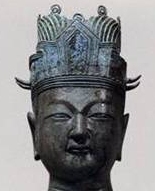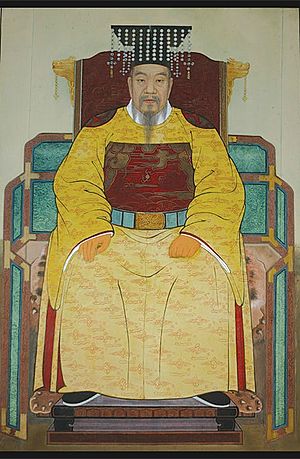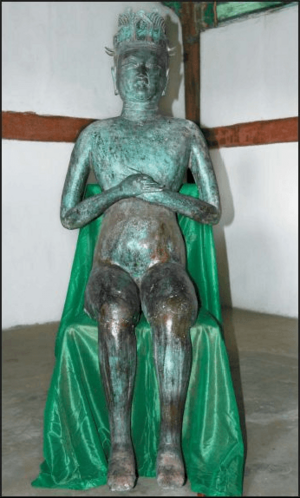Taejo of Goryeo facts for kids
Quick facts for kids Taejo of Goryeo고려 태조 高麗 太祖 Wang Geon (왕건) |
|||||||||||||
|---|---|---|---|---|---|---|---|---|---|---|---|---|---|
 |
|||||||||||||
| King of Goryeo | |||||||||||||
| Reign | 918–943 | ||||||||||||
| Coronation | 918 Pojeong Hall, Cheorwon Gate, Taebong |
||||||||||||
| Predecessor | Dynasty established
|
||||||||||||
| Successor | Hyejong of Goryeo | ||||||||||||
| Born | Wang Geon 31 January 877 Yonggeon's manor, Songak County, Hansan-ju, Kingdom of Silla |
||||||||||||
| Died | 4 July 943 (aged 66) Sindeok Hall, Gaegyeong, Kingdom of Goryeo |
||||||||||||
| Burial | Hyeolleung Royal Tomb | ||||||||||||
| Queen Consort | Queen Sinhye Queen Janghwa Queen Sinmyeong Queen Sinjeong Queen Sinseong Queen Jeongdeok |
||||||||||||
| Consort | Grand Lady Heonmok Lady Jeongmok Lady Dongyangwon Lady Sukmok Lady Cheonanbuwon Lady Heungbokwon Lady Daeryangwon Lady Hudaeryangwon Lady Daemyeongjuwon Lady Gwangjuwon Lady Sogwangjuwon Lady Dongsanwon Lady Yehwa Lady Daeseowon Lady Soseowon Lady Seojeonwon Lady Sinjuwon Lady Wolhwawon Lady Sohwangjuwon Lady Seongmu Lady Uiseongbuwon Lady Wolgyeongwon Lady Mongryangwon Lady Haeryangwon |
||||||||||||
| Issue |
|
||||||||||||
|
|||||||||||||
| House | House of Wang | ||||||||||||
| Father | Wang Ryung | ||||||||||||
| Mother | Lady Han | ||||||||||||
| Korean name | |
| Hangul | |
|---|---|
| Hanja | |
| Revised Romanization | Taejo |
| McCune–Reischauer | T'aejo |
| Birth name | |
| Hangul | |
| Hanja | |
| Revised Romanization | Wang Geon |
| McCune–Reischauer | Wang Kǒn |
| Courtesy name | |
| Hangul | |
| Hanja | |
| Revised Romanization | Yakcheon |
| McCune–Reischauer | Yakch'ŏn |
| Posthumous name | |
| Hangul | |
| Hanja | |
| Revised Romanization | Sinseong Daewang |
| McCune–Reischauer | Sinsŏng Taewang |
Taejo of Goryeo (born Wang Geon, 31 January 877 – 4 July 943) was a very important king in Korean history. He founded the Goryeo dynasty, which ruled Korea for a long time, from the 10th to the 14th century. Taejo was king from 918 to 943. He is famous for uniting the Later Three Kingdoms of Korea in 936.
Contents
Early Life and Family Background
Wang Geon was born in 877 in Songak, which is now Kaesong. His family was very powerful and involved in sea trade. His father was Wang Ryung. Historians believe Wang Geon's family were strong leaders. They had become wealthy through trade with China. They controlled their region, including the Ryesong River.
Wang Geon's ancestors might have been refugees from Goguryeo. Goguryeo was an ancient Korean kingdom. These refugees settled in the northern areas, like Songak. Songak later became the first capital of Later Goguryeo in 901.
Joining the Rebels
Taejo started his career during a difficult time in Korea. This period is known as the Later Three Kingdoms. The old kingdom of Silla was losing its power. Many local leaders and bandits rebelled against Queen Jinseong. She struggled to lead and help her people.
Two rebel leaders became very strong. They were Gung Ye from the northwest and Gyeon Hwon from the southwest. They defeated other rebel groups. In 895, Gung Ye's forces moved into the Songdo area. Wang Geon's father, Wang Yung, and other local leaders surrendered to Gung Ye. Wang Geon then joined Gung Ye's army.
Wang Geon's Military Successes
Gung Ye quickly saw Wang Geon's talent as a military leader. He promoted Wang Geon to general. Gung Ye even treated him like a brother. In 900, Wang Geon led a successful fight. He fought against local groups and the army of Later Baekje in the Chungju area. This made him even more famous.
In 903, he led a great naval attack. He targeted the southwestern coast of Hubaekje (Keumsung, later Naju). This happened while Gyeon Hwon was fighting Silla. Wang Geon led many more military campaigns. He also helped people who were poor under Silla's rule. People liked him because he was a good leader and very generous.
In 913, Wang Geon became prime minister of Taebong. Taebong was the kingdom Gung Ye founded. But Gung Ye, the king, started to change. He began to think of himself as a Buddha. He punished people who disagreed with his religious ideas. He even executed his own wife and two sons. People began to lose faith in him. His expensive ceremonies and harsh rule caused more problems.
Becoming King and Founding Goryeo
In 918, four important generals from Taebong met in secret. Their names were Hong Yu, Bae Hyeongyeong, Shin Sung-gyeom, and Bok Jigyeom. They decided to overthrow Gung Ye. They wanted Wang Geon to be their new king. Wang Geon was unsure at first, but he agreed.
That same year, Gung Ye was overthrown and killed. This happened near the capital, Cheorwon. The generals made Wang Geon the new king. He renamed the kingdom Goryeo. This was the start of the Goryeo Dynasty. The next year, he moved the capital back to his hometown, Gaegyeong.
Wang Geon made Buddhism the national religion of Goryeo. He also claimed the northern parts of the Korean Peninsula and Manchuria. He believed these lands were his rightful inheritance from Goguryeo. He wanted to rebuild the ancient capital of Pyongyang. He sent his cousin, Wang Sik-ryeom, to defend it. Pyongyang became the Western Capital. He also worked with local leaders. He preferred to make alliances rather than conquer them.
Uniting the Later Three Kingdoms
In 927, Gyeon Hwon of Hubaekje attacked Silla's capital, Gyeongju. He captured and killed King Gyeongae. Gyeon Hwon then put King Gyeongsun on the throne as a puppet king. After that, he turned his army towards Goryeo.
When Taejo heard the news, he planned an attack. He led 5,000 cavalrymen to stop Gyeon's troops. This battle happened at Gongsan near Daegu. Goryeo suffered a terrible defeat. Most of Taejo's army was lost, including his generals Kim Nak and Shin Sung-gyeom. But Goryeo quickly recovered. They successfully defended against Hubaekje's attacks.
In 935, the last king of Silla, King Gyeongsun, decided to surrender. He gave his entire kingdom to Taejo. Taejo happily accepted. He gave King Gyeongsun the title of prince. He also took King Gyeongsun's daughter as one of his wives. This made Gyeon Hwon very angry. Gyeon Hwon's own father also joined Goryeo.
Later that year, Gyeon Hwon's oldest son, Gyeon Singeom, led a coup. He and his brothers overthrew their father. Gyeon Hwon had favored his half-brother, Geumgang, to be the next king. Gyeon Hwon was exiled and imprisoned. But he escaped to Goryeo. Taejo treated him like his own father.
Goryeo's Victory and Unification
In 936, Wang Geon led his final battle. He fought against Singeom of Later Baekje. Singeom fought hard but was at a disadvantage. He surrendered to Taejo. Wang Geon officially took over Hubaekje. This united the Korean nation for the second time. He ruled until 943, when he died from an illness.
Taejo wanted to bring everyone together. He even gave titles and land to his former enemies. These included rulers and nobles from Later Baekje, Silla, and Balhae. Balhae was another kingdom that had fallen apart around this time. This helped bring stability and unity to his new kingdom.
After Balhae was destroyed in 926, its last crown prince, Dae Gwang-hyeon, and many nobles came to Goryeo. Wang Geon welcomed them warmly. He included them in his ruling family. This united the two nations that came from Goguryeo. Taejo felt a strong connection to Balhae. He called it his "Relative Country." He protected Balhae refugees, many of whom were also from Goguryeo. This was different from Later Silla, which had a bad relationship with Balhae.
Taejo did not like the Khitans, who had destroyed Balhae. In 942, the Liao dynasty sent 30 envoys with 50 camels as a gift. But Wang Geon exiled the envoys. He starved the camels under a bridge. This was his revenge for Balhae. He even suggested attacking the Khitans. In his Ten Mandates to his descendants, he warned them about the Khitans. He said they were like beasts and should be watched carefully.
Taejo's Lasting Legacy
The unification of the Later Three Kingdoms in 936 was very important. It was a more complete unification of the Korean people. Before this, in 668 CE, Silla had only united about half of the peninsula. The northern part was ruled by Balhae. Balhae saw itself as the new Goguryeo.
But Wang Geon's unification in 936 brought almost all the people under one state. After this, the people of the Korean Peninsula stayed under a single, unified state. This lasted until 1948. That's when Korea was divided into north and south.
The modern name "Korea" comes from "Goryeo." And "Goryeo" itself comes from "Goguryeo." Wang Geon and his kingdom claimed the heritage of Goguryeo. Because he was the first ruler to truly unite the Korean people, many modern Koreans look to him as an example. They hope for the current division of Korea to end.
Popular Culture
- Portrayed by Kim Myeong-jin in the 1970 film Wang-geon, the Great.
- Portrayed by Choi Soo-jong and Oh Hyun-chul in the 2000-2002 KBS1 TV series Taejo Wang Geon.
- Portrayed by Lee Mun-soo in the 2002–2003 KBS TV series The Dawn of the Empire.
- Portrayed by Joo Myung Nam in the 2009 KBS TV series Empress Cheonchu.
- Portrayed by Nam Kyung-eup in the 2015 MBC TV series Shine or Go Crazy.
- Portrayed by Jo Min-ki in the 2016 SBS TV series Moon Lovers: Scarlet Heart Ryeo.
- Leads the Korean civilization the games Sid Meier's Civilization III and IV
See also
 In Spanish: Wang Geon para niños
In Spanish: Wang Geon para niños
- Family tree of the Goryeo Dynasty
- Rulers of Korea
- History of Korea
- Wang (family name)
- Tomb of King Wanggon
- Founding legends of the Goryeo royal family
- Taejo Wang Geon (TV series)




